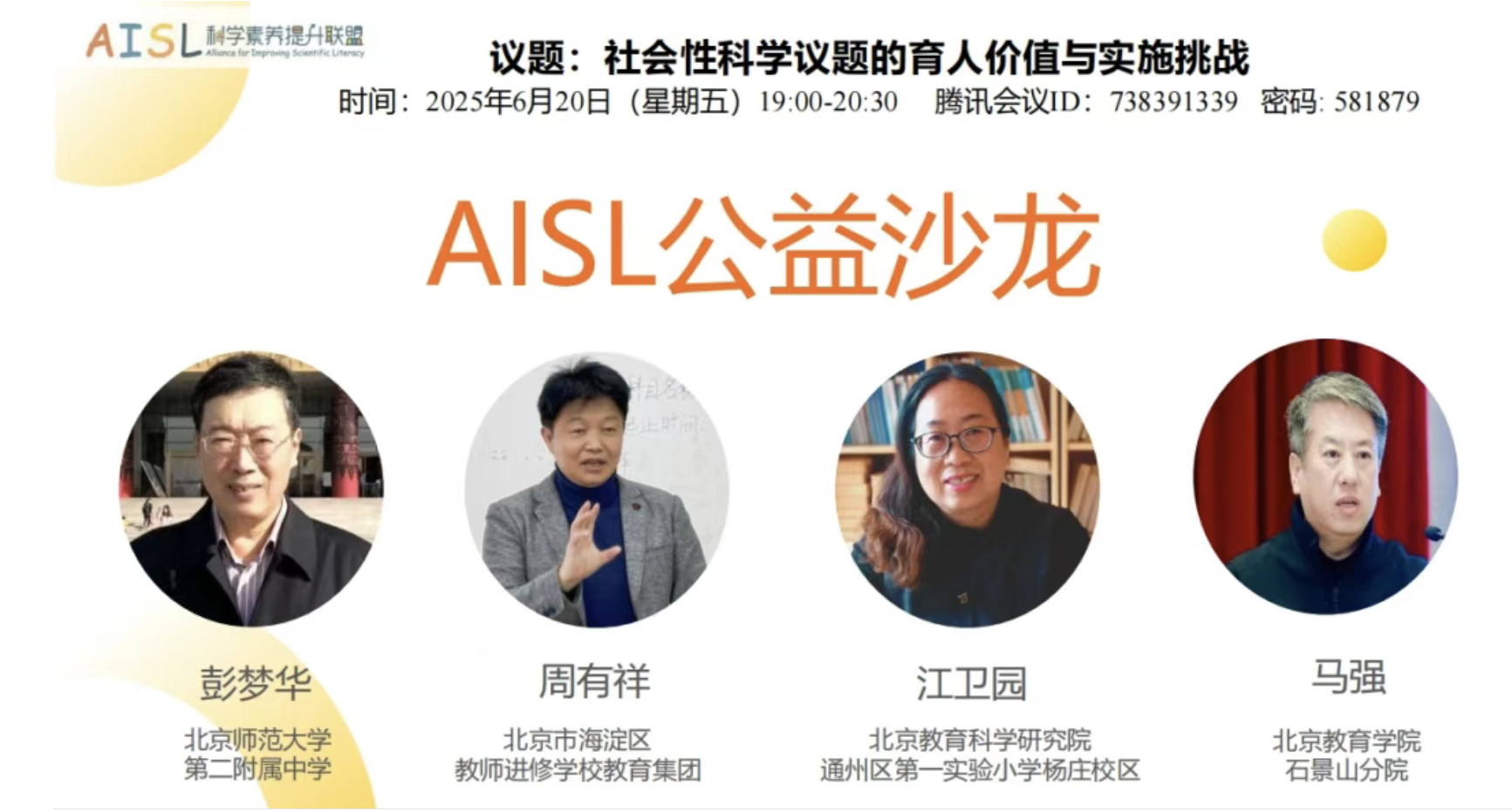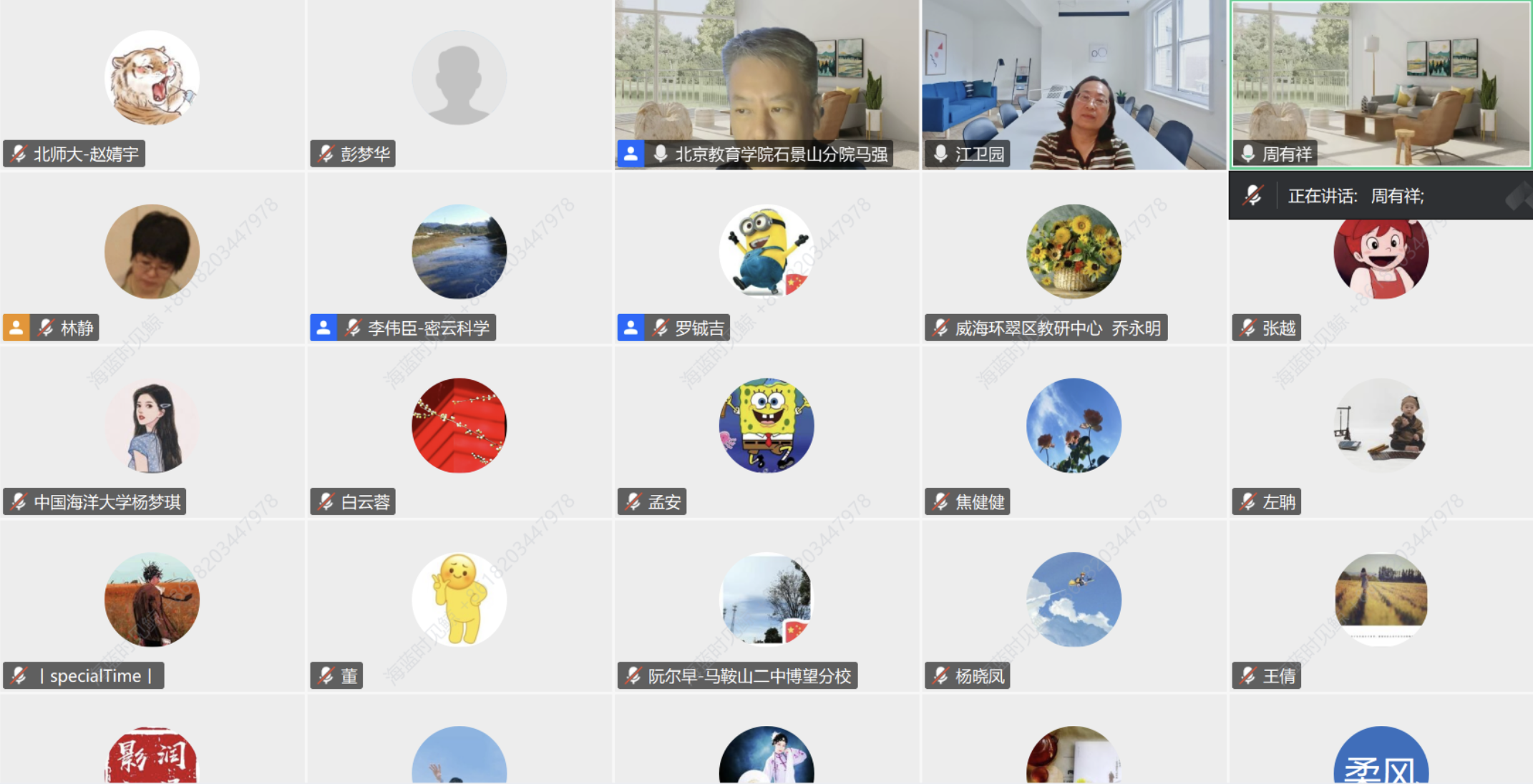 当科学教育直面真实世界的复杂议题,2025年6月20日的AISL公益沙龙展开深度对话。论坛由北京教育学院石景山分院马强主持,特邀北京师范大学第二附属中学物理特级教师彭梦华、北京海淀区教育进修学校生物学特级教师周有祥、北京通州区第一实验小学正高级教师江卫园等学科教学专家,聚焦“社会性科学议题学习”(SSI-L)落地的挑战与未来,共识清晰:SSI-L是激活科学教育、锻造未来公民的关键实践场。
当科学教育直面真实世界的复杂议题,2025年6月20日的AISL公益沙龙展开深度对话。论坛由北京教育学院石景山分院马强主持,特邀北京师范大学第二附属中学物理特级教师彭梦华、北京海淀区教育进修学校生物学特级教师周有祥、北京通州区第一实验小学正高级教师江卫园等学科教学专家,聚焦“社会性科学议题学习”(SSI-L)落地的挑战与未来,共识清晰:SSI-L是激活科学教育、锻造未来公民的关键实践场。
一、 议题生根:从儿童疑问到课程“活水”
SSI-L的源头活水在于学生的真实世界。江卫园举例:“议题‘零糖可乐随便喝吗?’源于课间学生困惑;‘湿地村庄必拆吗?’来自学生对身边事件的关切。”教师需学会“站在儿童立场,用儿童眼光看科技对社会影响”。议题在与学生的碰撞中自然生长。
如何让“活水”长流?江卫园分享“驱动性问题链”智慧:初期学生问题零散导致“费时低效”。通过构建6个逻辑严密的核心问题链,路径瞬间清晰。彭梦华则呼吁:“将SSI意识融入学科血脉”,他以自制教具(如电磁感应身份证模型)为例,证明跨学科思维与解决真实问题本应一体。
二、 实践突围:三大挑战的“破冰之策”
1. 时间困境:“10%课时活水”。江卫园直言常规课程课时紧张,难有开展SSI-L时间。破局之道:整合国家课程中10%的跨学科实践课时,巧借“三点半”活动与碎片时间。她坦言:“此乃权宜之计。”
2. 评价困境:“寻找丢失的光谱”。传统评价难捕捉SSI-L的高阶思维、社会责任感。江卫园困惑:“如何体现评价公平?”周有祥回应:“亟需构建专属的评价体系,超越知识点测试。”
3. 课程生命力:“避免昙花一现”。对于师生如此有益的SSI-L,如何避免仅被作为项目而悄然消失。江卫园的答案:深度融入学校基因——依托校本课程体系,将议题(如“零糖可乐”)嵌入科学单元,使SSI成为“课程的有机细胞”。
三、 教师蜕变:从讲授者到“思维领航者”
周有祥剖析教师在实施SSI-L中的转型之痛:
— 知识跨界与深度:需超越单科,拥抱前沿。AI可以帮助简化检索,但教师作为“思维引领者”更关键——引导学生多角度思考、批判分析。
— 课堂驾驭力:SSI无标准答案,要求高超的临场引导艺术。
— 价值审慎导航:在争议议题中(如拆迁伦理),需平衡科学、社会与文化。
彭梦华直指根基:“跨学科需扎实学科本体知识。物理老师若未学好物理,创新便是空谈。”他呼吁教师在对现状的“困惑与质疑”中寻求协同创新。
四、 未来图景:公民特质与教育生态的“共塑”
1. 塑造学校“公民气质”。江卫园坚信,深耕SSI-L将涌现“关注社会问题的教师”和“萌生公共参与意识的学生”,沉淀为学校特质——塑造负责任未来公民。
2. 驱动学习革命。周有祥预见,SSI-L将推动超越学科知识的学习成为主流,倒逼评价变革。
3. 回归教育“活水”。彭梦华强调,SSI-L核心在“以真实问题激发学习”。马强总结呼应:“问渠哪得清如许?为有源头活水来”——SSI-L正是注入素质教育生机的活水。
结语:在挑战中孕育新生
直面SSI-L跨学科主题学习中遇到的阵痛,需教育者勇气。SSI-L不仅是内容和教法革新,更是价值观重申——让科学教育扎根生活,指向未来公民的锻造。这场始于破解困境的教育变革,终将通向更辽阔的教育之路。

Anchoring Science Education in Reality: Socio-Scientific Issues (SSI) — Breaking Through Practical Barriers to Illuminate Future Classrooms
When science education confronts complex real-world issues, the AISL Public Salon on June 20, 2025, sparked profound dialogue. Hosted by Ma Qiang from the Beijing Institute of Education (Shijingshan Branch), the forum featured distinguished experts, including Peng Menghua, a Physics Special-Rank Teacher (特级教师) from Beijing Normal University Second High School, Zhou Youxiang, a Biology Special-Rank Teacher (特级教师) from Beijing Haidian Teacher Training School, Jiang Weiyuan, a Senior Teacher from Beijing Tongzhou No.1 Experimental Primary School.
Focused on challenges and prospects of Socio-Scientific Issues-Based Learning (SSI-L), the consensus was clear: SSI-L is a pivotal practice to revitalize science education and forge future citizens.
I. Rooting Issues: From Children’s Questions to Curriculum "Living Water"
SSI-L thrives on students’ real-world concerns. Jiang Weiyuan shared examples: "Is zero-sugar soda safe to drink freely?" (from students’ snack-time debates),"Must wetland villages be demolished?" (sparked by local news). Teachers must "adopt children’s perspectives to examine tech’s societal impact"—issues emerge organically through such engagement.
How to sustain the "Living Water"? Jiang’s "Driving Question Chains" method transformed scattered inquiries into six logical core questions, boosting efficiency. Peng urged "embedding SSI awareness into disciplinary veins," demonstrating with homemade tools (e.g., electromagnetic ID models) how cross-disciplinary thinking solves real problems.
II. Breaking Barriers: Solutions to Three Core Challenges
1. Time Constraints:
o Jiang advocated using 10% of mandated interdisciplinary class hours and afterschool slots ("3:30 PM activities"), calling it a "stopgap measure."
2. Assessment Gaps:
o Traditional tests fail to capture SSI-L’s higher-order thinking and social responsibility. Zhou stressed: "We need dedicated evaluation frameworks beyond knowledge-based exams."
3. Curriculum Longevity:
o To prevent SSI-L from fading as a "short-lived project", Jiang embedded issues (e.g., soda debates) into school-based science units, making SSI-L "organic cells of the curriculum."
III. Teacher Transformation: From Lecturers to "Thought Navigators"
Zhou analyzed teachers’ evolving roles:
· Interdisciplinary Depth: Mastery beyond single subjects, with AI aiding research—but teachers remain crucial to guide critical analysis.
· Classroom Agility: SSI’s open-endedness demands expert facilitation.
· Ethical Navigation: Balancing science, society, and culture in contentious issues (e.g., demolition ethics).
Peng underscored fundamentals: "Cross-disciplinarity requires solid subject knowledge. Physics innovation is void if teachers lack physics mastery." He urged collaborative innovation born from "doubts and critiques of the status quo."
IV. Future Vision: Co-Shaping Civic Traits & Educational Ecosystems
1. School-Wide "Civic Identity": Jiang envisioned SSI-L nurturing "teachers attuned to societal issues" and "students with civic awareness," defining school culture.
2. Learning Revolution: Zhou predicted that SSI-L would mainstream "learning beyond subjects," forcing assessment reforms.
3. Return to "Living Water": Peng asserted SSI-L’s core lies in "igniting learning through real problems." Ma concluded with a poetic nod: "What keeps the pond so clear? Living water from its source"—SSI-L is that revitalizing force for quality education.
Epilogue: Growth Through Challenge
SSI-L’s growing pains require the courage of educators. This is not only about pedagogical innovation but also a reaffirmation of values: grounding science education in real life to shape future citizens. This reform, stemming from problem-solving, will pave the way for a broader educational future.
